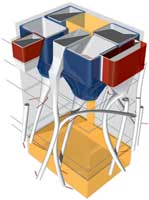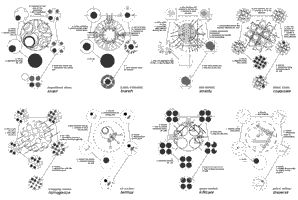WWW.HAUSSITE.NET
The Wild City
12 / 04 / 02
Lecture / Presentation
The Wild City
Genetics of Uncontrolled Urban Processes
STEALTH group (YU / NL): Ana Dzokic, Milica Topalovic, Marc
Neelen and Ivan Kucina


This project examines a city in crisis - a complex and trembling ground on which the rules for the production of urban substance and the logic of urban vitality are constantly being reinvented. It spans two conceptual territories: a metaphorical one, which describes an urban paradigm of wildness; and a strategic one, which proposes dynamic design procedures for an environment that is subject to dominant market forces and the decline of institutions.
The research starts from the reality of Belgrade, capital of Yugoslavia, city that recently experienced an abrupt change from centralised to atomised growth as the result of a decade of crisis. The trigger for the metamorphosis of the city was the United Nations embargo of 1992, amidst an atmosphere of war trauma, media obsession and politicisation. While the city's institutions lost their power during this period, private initiative started to take control of new developments in the city.
In this context, as a compensation for the collapsing state and institutions, the unleashed individual initiative led to innovation in literally every urban domain, from commerce to housing production and public services. A new, non-regulated structure emerged, flooding the public realm and superimposing a layer of mutants on the existing city. In this continuing process of change the city acts as a machine for production of new urban forms and as generator of its own substance. Innovations are present at all scales and on various levels: spatial, physical, architectural typology, ownership, organisational structure, program.
The research into urban genetics focuses on the evolutionary, time-based character of non-regulated transformations. It is a practice of discovering the inherent logic of emergent processes, based on the assumption that the result is often more sophisticated than a conventionally designed one. Through this, a set of tools and a specific methodology have been experimentally developed to visualise, monitor and, to a certain extent, predict spatial and organisational changes over time.
In nearly all of the studied processes, pulsating and flexible models have been achieved, resembling profound symbiotic forms. Their organisation is typically non-hierarchical and newness is produced through conflict and negotiation between institutions and individuals. Following the observation that there is a pattern of similar behaviour among 'urban genes' - the successive stages of the observed processes - these patterns were collected and developed into an urban design tool. While its rules are fairly simple, the complexity that arises from it is able to maintain the character of a self-organising system, with a heterogeneous and vivid spatial formation.
At a strategic and professional level, the Wild City examines the role of the architect as one confronted by urban-design restrictions. The paradigm of 'wildness' emerged through non-planned and scarcely regulated processes. In the urban domain, these processes feature a remarkable degree of innovation and led to possibilities for redefining institutional participation in the creation of urban space. At a conceptual level, the project shows a city that acts as an incubator of new urban forms. This part of the project draws its metaphors and parallels from studies of genetics and computer viruses.
about:
The Wild City (www.archined.nl/wildcity) is a collaborative project by Ana Dzokic, Milica Topalovic, Marc Neelen and Ivan Kucina. It has been developed both through a research at the Berlage Institute, Postgraduate Laboratory of Architecture (Rotterdam), and through the practice STEALTH group (Rotterdam/Belgrade). Recently it has been published in the architectural magazine 'Hunch' No. 4. The project formed part of the Mutations exhibition (USE) - Bordeaux, Brussels, Tokyo and Milan, it has been presented at Berlin Beta 2001 conference and V2_WireTap. The project builds up the content of the DataCloud 2.0 browser (http://datacloud2.v2.nl), currently developed by V2_Lab and ArchiNed.
